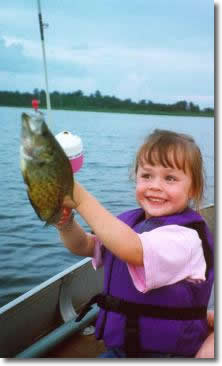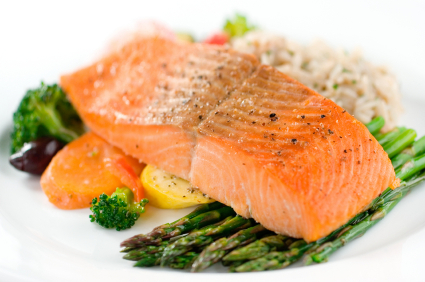Fish Consumption
- Fish Consumption Home
- Waterbody-specific and Statewide Guidelines
- Contaminants and Minnesota Fish
- Order Fish Consumption Materials
- Eating Fish: Benefits and Serving Size
- Resources, Reports & Technical Information
- Great Lakes Consortium
- Information in Other Languages
Related Topics
Environmental Health Division
Contact Info
Benefits of Eating Fish and Serving Sizes
Two omega-3 fatty acids found in fish are EPA (eicosapentaenoic acid) and DHA (docosahexaenoic acid). Our bodies don't produce these omega-3 fatty acids so we must get them through the food we eat. Omega-3 fatty acids are found in every kind of fish, but are especially high in fatty fish. Some good choices are salmon, trout, sardines, herring, canned mackerel, canned light tuna, and oysters.
Omega-3 Fatty Acids:
- Help maintain a healthy heart by lowering blood pressure and reducing the risk of sudden death, heart attack, abnormal heart rhythms, and strokes.
- Aid healthy brain function and fetal development of vision and nerves during pregnancy.
- May decrease the risk of depression, ADHD, Alzheimer’s disease, dementia, and diabetes.
- May prevent inflammation and reduce the risk of arthritis.
Health experts recommend that fish be included as part of a healthy diet:
- 2020-2025 Dietary Guidelines for Americans (PDF)
- American Heart Association
- Mayo Clinic: Omega-3 in fish: How eating fish helps your heart
For recipes and other information about eating fish, go to Choose Your Fish.
Choosing Fish to Eat
When choosing which fish to eat, some people need to be more careful than others. It's important you make your fish choices based on who you are.

Young children (under 15 years old) and fetuses are more sensitive to mercury. Too much mercury can cause lasting problems with understanding and learning. However, studies show children benefit developmentally when moms eat fish low in mercury during pregnancy.
Video: New information for women to choose the best fish
How clean a lake looks is not a sign of how safe the fish are to eat
Mercury is found in most fish – both locally-caught and store-bought.
- How much mercury is in fish depends on:
- Species. Some fish have more mercury than others because of what they eat and how long they live – Bass, Northern, and Walleye have higher levels than panfish.
- Size. Smaller fish generally have less mercury than larger, older fish of the same species. Unlike people, fish do not get rid of mercury.
- Fish from lakes in northeastern Minnesota generally have more mercury than in southern and central Minnesota.
- Fish bought at a store or restaurant also contain mercury. Farm-raised fish, such as salmon, are low in mercury but can contain other contaminants that may be found in fish feed. The amount of contaminants is small enough that farm-raised salmon are still good to eat 2 times a week.
Perfluorooctane Sulfonate (PFOS) is found at low levels in fish throughout the state. Higher levels have been found in fish from some waters in the metro and Duluth areas. See also PFAS in fish from Minnesota Pollution Control Agency.
Polychlorinated biphenyls (PCBs) are highest in fatty fish such as Carp, Catfish, and Lake Trout from major rivers and Lake Superior.
See Contaminants and Minnesota Fish for more information.
What is a serving of fish?

MDH's Fish Consumption Guidelines give advice for the number of servings of fish to eat per week or month. The guidelines are based on fish fillets or muscle tissue; the part of the fish studied statewide through an interagency Fish Contaminant Monitoring Program.
| Body Weight | Weight in ounces of uncooked fish | Approximate weight after cooking |
|---|---|---|
| 50 | 3 | 2.25 |
| 70 | 4 | 3 |
| 90 | 5 | 3.75 |
| 110 | 6 | 4.5 |
| 130 | 7 | 5.25 |
| 150 | 8 | 6 |
| 170 | 9 | 6.75 |
| 190 | 10 | 7.5 |
| 210 | 11 | 8.25 |
- One piece of sushi is about one ounce.
- A fast food fish sandwich is typically between four and five ounces of cooked fish.
- A serving of fish is based on the body weight of the person eating the fish. For example, ½ pound (or 8 ounces) of uncooked fish is one serving for a 150-pound person. Eight ounces of uncooked fish is equal to about 6 ounces of cooked fish.
- To adjust meal serving size for a heavier or lighter weight person, add or subtract 1 ounce of fish for every 20 pounds of body weight.
Monthly fish menu ideas: Examples that meet Statewide Safe-Eating Guidelines
| Month 1 1 meal of halibut AND | Month 2 1 meal of canned white tuna AND |
|---|---|
| Week 1 2 meals of salmon | Week 1 1 meal of salmon AND 1 meal of catfish (farm-raised) |
| Week 2 1 meal of MN-caught bluegill | Week 2 1 meal of MN-caught crappie |
| Week 3 1 meal of canned light tuna | Week 3 1 meal of MN-caught crappie |
| Week 4 1 meal of catfish (farm-raised) AND 1 meal of tilapia | Week 4 1 meal of herring AND 1 meal of tilapia |
| Month 3 1 meal of MN-caught walleye (less than 20 inches) AND | Month 4 1 meal of tuna (steak) AND |
|---|---|
| Week 1 1 meal of shrimp AND 1 meal of tilapia | Week 1 2 meals of salmon |
| Week 2 1 meal of MN-caught bluegill | Week 2 1 meal of salmon AND 1 meal of crab |
| Week 3 1 meal of pollock AND 1 meal of cod | Week 3 1 meal of light canned tuna |
| Week 4 1 meal of salmon AND 1 meal of scallops | Week 4 1 meal of catfish (farm-raised) AND 1 meal of tilapia |
Note: Where the guidelines recommend one meal per week or month, you may prefer to have two smaller sized meals over that week or month.